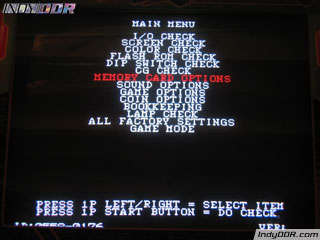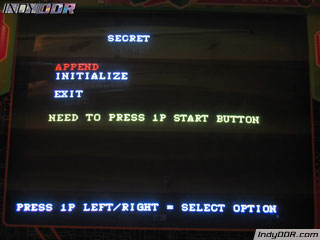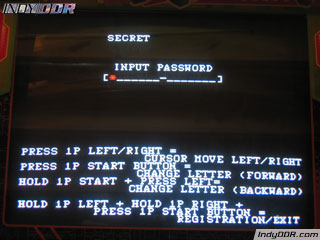
about ddr |
forums |
buy ddr |
radio |
song lists |
FAQs |
machine locations |
radio |
song lists |
FAQs |
machine locations |
 |
|
|
Songlists and Codes / FAQ
FAQs - DDR 4th Mix Unlock Codes Machine owners/operators have the ability to unlock new songs for the game through the operator menu. Here are the instructions you need to follow to unlock an arcade machine. Please note that if you do not have access to the panel behind the coin door (ie - if you don't own the machine nor are you responsible for it), you cannot enter the unlock codes. Thanks go to Brian Ho of IndyDDR.com for providing the images of his own machine.
To enter the operator menu, you must hit the Test button. The pictures above show the two styles the operator panel can come in - the lefthand one in original Japanese machines, and the righthand one in Korean/Asian/US machines. In the picture on the left, the Test button is the top one in the column of three buttons (the other two, in order, are Service and Degauss). In the picture on the right, the Test button is the red one in the upper-righthand corner, and the white button next to it is the Service button. Once you hit the Test button, you'll see a menu as follows:  Use the  From here, hit the 1P  You can now type in the unlock codes. Use The unlock codes for this game are as follows:
If you've done this correctly, you should have 12 new songs highlighted in yellow during song selection. Step Codes and other notes From the screen where you select whether you wish to play Single, Versus, or Double, you may enter From Main Mode, you may select which genre of songs you wish to play. In each genre, songs are listed in one of three colors:
After selecting a song, you may choose which level of difficulty (Basic/Trick/Maniac) you wish to play. You may also choose to play the Battle steps for a song, if you are playing a Versus game, by pressing You can also enter the following step codes. To cancel Left, Right, Mirror, and Shuffle, enter the appropriate code again.
Memory Card Operation DDR 4th Mix is a bit unique in how the memory card functions work in the game. 4th Mix offers Internet Ranking, custom-order Nonstop courses, and Edit Data. To use these features, you need a memory card for Internet Ranking, a properly-formatted Link Data file. For details on how Link Data works, please see the Memory Card FAQ. When starting a game with a memory card inserted, the game will default to Link Mode, which is required for using memory card features. Upon selecting Link Mode, the player will be presented with three options: Edit Data, Nonstop, and Internet Ranking. When Nonstop is chosen, the game will attempt to load any existing custom nonstop courses saved to your memory card. A maximum of six courses can be loaded on each play (three for each player's memory card); for every course that isn't loaded, a default Nonstop is loaded instead according to the list below. Similarly, when Edit Data is chosen, the player is presented with 30 slots, able to load a maximum of 15 edits per memory card. For each slot that is not filled with an edit, the game will instead substitute normal steps for songs in order of popularity (eg - Players' Best). So, if 28 edits are loaded, for example, the two remaining slots will be reserved for the two most popular songs on the machine. This is fairly restrictive compared to the Edit Data model on all other DDR machines, where players are freely allowed to choose songs regardless of the edits available, as well as the desired difficulty. The exception to this restriction is for edits that are loaded on the machine by the arcade operator. These do not require Link Mode to be accessed; they can be accessed identically to S-Maniac steps in Main Mode. Internet Ranking is no longer a useful option. Previously, choosing this option would have the player perform a preset Nonstop course, and the game would save a password on the memory card which could be loaded at a later time on a home version game and entered into Konami's Internet Ranking website for players to post competitive scores. This option did not require a memory card, but a memory card made it more useful, as players were not forced to quickly write down their passwords. However, as Konami has closed all of its Internet Ranking pages, these passwords are no longer useful. Grading and Score Grades: AA - A - B - C - DFor those who don't care about the exact formula for calculating the score of a combo, it will suffice to say that Perfects are worth just a little more than Greats, and that steps are worth more as your combo increases, but not nearly as much as it did in DDR 2nd Mix. For those who do care, let n be the number of the step in the combo. Then, the point value for the nth step is:
S(n) = G(n) if the step is a Great step, and P(n) is the step is a Perfect step; Therefore, the total point value for a combo of n steps is the summation of S(n) from 1 to n. I must thank EnoOn for telling me how the scoring system for DDR 4th Mix worked. I don't think I would have had the patience to figure this out myself. |
|||||||||||||||||||||||||||||||||||||||||||||||||||||||||||||||||||||||||||||||||||||||||||||||||||||||||||||||||||||||||||||||||||||||
|
|
Copyright © 2005 DDR Freak, LLC - All rights reserved Konami images used with express permission of Konami Corporation. |
|||||||||||||||||||||||||||||||||||||||||||||||||||||||||||||||||||||||||||||||||||||||||||||||||||||||||||||||||||||||||||||||||||||||